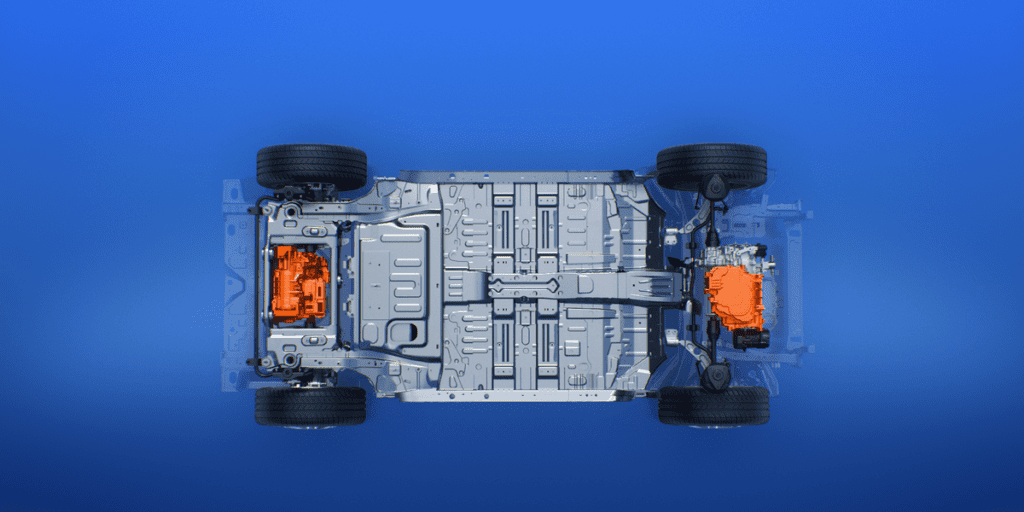Stellantis's STLA Medium EV Platform Will Underpin First U.S. Model in 2026

Stellantis has revealed details about the STLA Medium EV platform, which will debut in the U.S. as an electric Chrysler model in 2026.STLA Medium will offer standard- and long-range batteries, with the latter offering a 98.0-kWh useable capacity that could provide about 370 miles of range.Along with a 400-volt electrical system, the platform can be configured with front- or all-wheel drive.
Two years ago, Stellantis announced plans to introduce four global electric-vehicle platforms. They included the STLA Small, Medium, Large, and Frame designations, and today the company has revealed details about the STLA Medium platform, which will be the first of the four to reach production starting this year in Europe.
While the first EV to utilize the STLA Medium platform will be the next-generation Peugeot 3008, which is only sold overseas, the first U.S. model will come from the Chrysler brand, but that’s not expected to arrive until 2026. The Chrysler Airflow concept teased what this new EV might be like back in 2021, but it’s currently unclear how similar it will be to the production version—or if it will even be called the Airflow.
STLA Medium Specs
Like most EV platforms, the STLA Medium is modular, meaning it can be configured with different dimensions, suspensions, and more. Along with wheelbases that range from about 106 to 114 inches, it can be equipped with a single electric motor on the front axle or motors on both axles. The former setup obviously provides front-wheel drive, and the latter provides all-wheel drive. Stellantis says power output will range from about 214 horsepower to up to around 382 horses.
The STLA Medium platform will also offer two battery sizes. Stellantis only revealed details about the larger battery with a 98.0-kWh useable capacity. The company says that’s expected to provide 435 miles of range per charge, but that’s based on the optimistic European WLTP test cycle. That translates to around 370 miles of range based on the EPA’s methodology. Stellantis did say the smaller standard battery is expected to provide 310 miles of WLTP-estimated range—or about 264 miles for the likely EPA estimate.
While some of the latest EVs feature a more powerful 800-volt electrical architecture, the STLA Medium platform will use a 400-volt system. This is said to enable the battery to charge from 20 to 80 percent in 27 minutes using a DC fast-charger. In a virtual meeting today with reporters, Stellantis CEO Carlos Tavares said the main reason the company made that decision was to help keep the upcoming EV models affordable. He did say that the STLA Medium platform was designed to accept an 800-volt system, so it’s possible to introduce that down the road.
Not only is the STLA Medium platform designed to switch from a 400- to an 800-volt electrical system in the future, but Stellantis says it will be be able to accept new battery chemistries such as solid-state as well as nickel- and cobalt-free packs. To help with packaging costs and production volumes, the perimeter dimensions of the STLA Medium’s battery packs are both the same and feature common tray and cooling designs.
Stellantis plans to produce 2 million STLA Medium-based EVs per year, with the first batch starting in Europe and then heading to other markets. While U.S. customers will have to wait a couple of years, it’s expected that the Chrysler EV will quickly be followed by models from other Stellantis brands, specifically Jeep. Last fall, the company previewed the Wrangler-like electric Recon, and today Stellantis representatives mentioned that the STLA Medium platform will underpin EVs with “high off-road capability.”
Senior Editor
Eric Stafford’s automobile addiction began before he could walk, and it has fueled his passion to write news, reviews, and more for Car and Driver since 2016. His aspiration growing up was to become a millionaire with a Jay Leno–like car collection. Apparently, getting rich is harder than social-media influencers make it seem, so he avoided financial success entirely to become an automotive journalist and drive new cars for a living. After earning a journalism degree at Central Michigan University and working at a daily newspaper, the years of basically burning money on failed project cars and lemon-flavored jalopies finally paid off when Car and Driver hired him. His garage currently includes a 2010 Acura RDX, a manual ’97 Chevy Camaro Z/28, and a ’90 Honda CRX Si.



